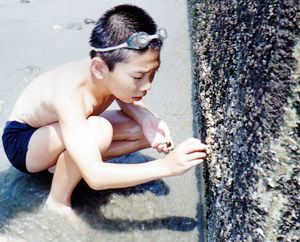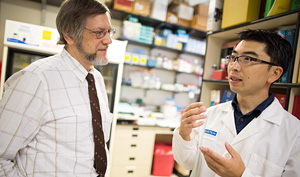

Lauding Lab Lieutenants
Tadakimi Tomita: Reeling In the Structure of a Ubiquitous Parasite
Dr. Tadakimi Tomita, a postdoctoral researcher in the lab of Dr. Louis Weiss, first learned the value of hard work growing up on a mushroom farm in Nagoya, Japan. Drawn to his natural surroundings—catching fish and playing with insects were favorite pastimes—the son of two artists-turned-farmers also developed a passion for science.

A young Tadakimi examines sea life by the seashoreHe came to the United States after high school to study biology at the University of Bridgeport, where he was president of the fishing club and also met his wife. Upon graduating, he went home to Japan for a stint as a laboratory technician in a sugar refinery factory before returning to the U.S. to work in a microbiology laboratory at Pepsico, in Valhalla, NY.
A Fateful Meeting
Following the advice of his supervisor at Pepsico to go into academia, in 2004, Dr. Tomita found work as a research technician in the lab of Einstein's Dr. Amos Orlofsky, assistant professor of pathology. There he helped with basic experiments, learning how to troubleshoot, design experiments logically and review the results critically. And, it was in the Orlofsky lab that he was introduced to Toxoplasma gondii.
T. gondii is a protozoan parasite of mammals and birds. It can infect any warm-blooded animal and can cause disabilities such as encephalitis, and even death. It is transmitted via infected food, soil, water and transfusions, and it can travel through the placenta to the unborn fetus. Cats are the primary host because the parasite can reproduce within their intestines. That's why pregnant women are often advised to avoid handling kitty litter.
Despite recent progress in understanding the biology and structure of the rapidly replicating form of T. gondii, little is known about the cyst form, which plays a critical role in latent infection.
A Fishing Expedition
In 2009, Dr. Tomita joined the parasitology laboratory of Dr. Louis Weiss, professor of pathology and of medicine at Einstein, as a graduate student. His mission: to uncover the architecture of T. gondii cyst.
Dr. Weiss asked his mentee to "embark on a fishing expedition" and "throw out a net" to find what proteins make up the T. gondii cyst wall.
"We didn't know what we were looking for, other than that we wanted to find the structural composition of the cyst wall," Dr. Weiss recalled.
"Tadakimi was one of those graduate students I'm blessed to have had come through the lab," he added. "He is extraordinarily creative and has a real ability to work through problems and come up with interesting things on his own."
The Big Prize

Dr. Tadakimi Tomita with his mentor, Dr. Lou WeissAfter years of dedication and tenacity, Dr. Tomita netted the big prize. He discovered and characterized a novel glycoprotein (CST1) that is responsible for structural integrity of the T. gondii cyst wall and likely functions as a scaffolding protein – one that other proteins bind to – for assembling that structure.
"We found that when we knock out this protein, the parasite cyst becomes fragile," he explained. "That was new to cyst wall biology. I was really excited."
He produced a new monoclonal antibody to T. gondii cysts, which he named "Salmon E." The findings were published in PLOS Pathogens in 2013.
As a graduate student, Dr. Tomita developed other monoclonal antibodies—nicknamed "whale" and "anchovy"—that recognize the different components of the cyst wall. Using proteomic approaches, he purified the corresponding antigens.
His research generated strong interest at the 12th International Toxoplasmosis Congress at Oxford, in 2013. And he has had his work published in three high-impact journals. He contributed to the characterization of the type II KU80 T. gondii strain, which appeared in Eukaryotic Cell and has become a seminal paper in the field.
Going After Glycans
In March 2014, Dr. Tomita defended his thesis, "The Toxoplasma Gondii Cyst Wall Glycoprotein CST1 is Critical for the Structural Integrity of Brain Cysts." As a postdoc, he is working on purifying the cyst wall protein of T. gondii to pave the way for studies to determine what kind of glycans (sugars) are attached to the protein's mucin domain, or protective covering.
"Here at Einstein, I've been fortunate to collaborate with Drs. Pamela Stanley and Peng Wu, who provide vast expertise and priceless advice," said Dr. Tomita.
Preparing to Nurture the Next Generation
"Over the six years we've worked together, I've seen Tadakimi blossom as a researcher and as a presenter," said Dr. Weiss. "He's a wonderful collaborator, and his skill set as a molecular parasitologist is second to none."
Equally impressed by Dr. Tomita's innate teaching ability, Dr. Weiss recommended him for the BETTR program, a three-year teaching fellowship offered to a select group of postdocs at Einstein each year.
Later this month, as part of his BETTR activities, Dr. Tomita will begin shadowing biology teachers at Lehman College, where he will also take teaching courses. Next year he'll have the opportunity to teach undergraduate courses. His ultimate career goal: to teach undergraduates while remaining in research. He hopes to instill in his students, and in his own three children, the love of science that once fueled the imagination of a boy in rural Japan.
Posted on: Monday, September 21, 2015

Tablet Blog